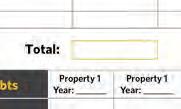
HANDBOOK P: E: Holly Matthews-Houk Branch Manager | NMLS #1289185 (513) 227-9983 hmatthews@S1L.com
PRIVACY POLICY
Certain pages of this mortgage guide summary provides approximations for informational purposes only and is not intended to provide financial, legal, or tax advice. All summaries are hypothetical for illustration purposes and do not constitute an offer to lend Contact a licensed mortgage professional for an official loan quote for your individual financial scenario. We do not guarantee the accuracy or applicability of the summary to your individual circumstances. Your use of the mortgage guide does not impose any legal obligations or responsibility on Synergy One Lending. The summary should not be relied on as the only source of information for making financial decisions. Consult a qualified financial advisor before making important personal financial decisions.
Ultimate Homebuyer’s Handbook 2
There are four keys to unlocking a mortgage and securing your new home: Identity, Credit, Income, and DTI. To obtain a deeper understanding of the mortgage process, follow this guide.


Ultimate Homebuyer’s Handbook 3
IDENTITY CREDIT INCOME DEBT TO INCOME THE 4
KEYS
may believe that your identity only consists of the card in your wallet or handbag that states your address or height; however, your identity is much more specific as it relates to a home mortgage, because your lender needs to know exactly who you are and what you want to do with the property.

Ultimate Homebuyer’s Handbook 4 You
Three categories in your lender’s identity profile include: KEY #1 IDENTITY • Personal Identity • Occupancy • Co-Signer
PERSONAL IDENTITY
Your identity is the first key to unlocking your mortgage—you’ll be able to utilize the next key when you determine which of these categories are applicable. To obtain a traditional qualifying mortgage, you must be one of the following: • US citizen • Permanent resident • DACA: Deferred Action for Childhood Arrivals*
There are loans and ways to purchase homes without a traditional loan, such as Non-Qualified Mortgage. **If you fall under this group, please contact me.
What type of homebuyer are you?
Who’s a first-time homebuyer?
A person who has not owned or co-owned a home in the last three years. You may need to be a first-time homebuyer to qualify for many down payment assistance programs.

Who’s a non-first time homebuyer?
Someone who has owned or co-owned a residence in the past three years.
Are you a Veteran?
Use VA Form 26-1880 to apply for a VA home loan Certificate of Eligibility (COE). You must bring the COE to your lender to demonstrate your eligibility for a VA home loan.
circumstances.
Ultimate Homebuyer’s Handbook 5
*As of January 19, 2021, the Federal Housing Administration (FHA) is allowing
classified under
Arrivals (DACA) program and those legally permitted to work
to apply
FHA mortgage.
get
These
anyone
the Deferred Action for Childhood
in the U.S
for an
**A Non-Qualified Mortgage (Non-QM) is a loan that doesn’ t meet the standards of a qualified mortgage and uses non-traditional methods of income verification to help a borrower
approved for a home loan
types of loans are for borrowers with unique income qualifying
OCCUPANCY
Owner Occupied:
You intend to live in the house and must move in within 60 days of closing your loan, according to the terms of the Deed of Trust. You will also need to certify that you will reside in the home for a minimum of one year.
Investment Homes:
You intend to purchase the property to rent it to a tenant. If there are current occupants in the house or units, lenders will require a lease agreement.
Two types of investors: New & Seasoned
• Seasoned - A person who has owned an Investment property for more than two years claiming rental income on Schedule E of their taxes
• New - A person who has not owned an Investment property for two years
Second Homes:
A home you own that’s not your primary residence, but whose primary function is not an investment property. To qualify as a second home, you must live in it for at least part of the year.
Ultimate Homebuyer’s Handbook 6
CO-SIGNER
The mortgage application and associated loan documentation are signed by a co-signer, who promises to be responsible for the debt. In other words, if the primary borrower (you) defaults on the payments, the ‘co-signer’ is equally liable and responsible for the mortgage debt.
The co-signers’ income, assets, and credit history will be used alongside the primary borrowers to qualify for the loan. However, they will not have any rights to the property title or ownership. Co-signers are also not required to live on the purchased property.
Any additional borrower listed on the mortgage application whose income, assets, and credit history are used to qualify for the loan is referred to as a co-borrower (or co-applicant). Both co-borrowers share equal responsibility for mortgage payments and are usually listed on the title to the home. Typically, a co-borrower is a spouse or partner; however, a coapplicant can also be a friend or family member.
Co-borrowers can also be a non-occupying co-borrower. This means that they do not have to live in the home that the loan is for.
Now let’s identify the qualities of a great co-signer:
• Good creditworthiness (Be sure they have the same or better credit than you because your lender will base the decision on the lowest middle score)
• Substantial employment (Someone who has been employed for 2, or more, years)
• Minimal debt (If they have too much debt, it can hinder your eligibility)

• Lives at home, rent-free or mortgage-free (you must include the debt of your co-signer if they have a mortgage or rent payment)
When using a co-signer/co-borrower, there are some general rules:
• A VA loan requires your spouse to be the other signer/borrower
• VA and FHA loans require you to factor in your spouse’s liabilities
• If you are a co-signer on one loan and want to take out another mortgage to buy a new home, you need to wait 12 months and show a year of successful payments made by the primary borrower
Having a cosigner or co-borrower to buy a house is not a requirement but having one can boost your likelihood of getting approved, especially if they exhibit all the traits that make for a good co-signer or co-borrower.
Ultimate Homebuyer’s Handbook 7
There are three categories used to break down your credit. The most crucial factor is your credit score. Also, consider your public records, tradelines, monthly bills, and all liability restrictions.
After the credit breakdown, there will be a sample workbook to assist you in calculating your monthly liabilities.

Ultimate Homebuyer’s Handbook 8
KEY #2 CREDIT CR E DI T CREDIT SCORE PUBLIC RECORDS LIABILITY TRADELINES
CREDIT SCORE



Your credit reports are created by the three major credit bureaus—Equifax, Experian, and TransUnion—and use scoring models like VantageScore and FICO to generate a score that normally ranges from 300850. The credit bureaus can also use their proprietary models to determine your ratings.


Your credit score is usually determined by how often you make on-time payments and how many accounts you have in good standing. The middle of the three credit scores is used when assessing approval of your home loan. In addition, the lowest middle score for all loan applicants is chosen. Personal information such as race, gender, religion, marital status, or national origin will never be considered when calculating your score. If you need help with credit repair, we can be of service.
If you know your scores, make a note of them in these fields for future reference.
Ultimate Homebuyer’s Handbook 9
PUBLIC RECORDS
Public records contain public data on your credit report as well as the discharge or dismissal dates from your most recent bankruptcy (BK), a short sale (SS), or foreclosure—the public record matrix will show if you’ve ever filed for bankruptcy.

Chapter 7
This section of the Bankruptcy Code addresses “liquidation,” which is the sale of a debtor’s nonexempt property and the distribution of the proceeds to creditors.
Chapter 11
This section of the Bankruptcy Code generally allows for reorganization, which is usually done through a corporation or partnership. A chapter 11 debtor typically proposes a reorganization plan to keep its business running and pay creditors over time. Individuals or companies can also seek relief under Chapter 11.
Chapter 13
This section of the Bankruptcy Code addresses adjusting an individual’s debts concerning regular income. Chapter 13 bankruptcy allows debtors to keep their property while repaying their debts over three to five years.
Short Sales
A short sale is the sale of real estate property for which the lender is prepared to accept less than the outstanding mortgage balance.
All numbers depicted in years
For a sale to be considered a short sale, these two things must be true:
• The homeowner must be so far behind on payments that they are unable to make up the difference.
• The housing market must have tanked to the point where the house is now worth less than the mortgage balance. The lender (and the homeowner) will usually try a short sale process to avoid foreclosure.
Foreclosures
Foreclosure is the legal process by which a lender attempts to recoup the amount owed on a defaulted loan by seizing and selling the mortgaged property. Typically, default occurs when a borrower fails to make a certain number of monthly payments. However, it can also happen when the borrower fails to meet other mortgage agreement terms.
Repos
A repo, also known as a repurchase agreement, is shortterm borrowing for government securities dealers. In the case of repo, a dealer typically sells government securities overnight to investors and repurchases them the next day at a slightly higher price.
LIABILITY TRADELINES
Your credit accounts that are reported to credit reporting agencies are known as tradelines. Each tradeline offers extensive account information. Banks look at four different tradelines to figure out how you pay back debt, however, they do not look at the Not Applicable line items below.

Revolving
The debt you’ve accumulated from your many revolving credit lines is referred to as revolving debt. Credit cards and lines of credit are the two most frequent types of revolving debt. Payments on revolving debt are not fixed each month and vary depending on your balance plus interest costs
Installment
An installment debt is a loan paid back in regular installments by the borrower. In most cases, an installment loan is returned in equal monthly payments that include interest and a portion of the principal.
Mortgage
A mortgage is a debt instrument secured by the collateral of specified real estate property that the borrower must repay over time.
Delinquent
A debt becomes delinquent when a payment is not made by the due date, the end of the “grace period” specified in a loan or repayment arrangement, or when a debt is paid in installments.
N/A
These debts are not looked at by banks.
Ultimate Homebuyer’s Handbook 11
DEBT WORKSHEET INSTRUCTIONS

To ensure you don’t forget anything, we’ve included a worksheet on the following page. Don’t worry about filling every line. Use only the ones that are most applicable to your scenario.
Step 1. Total Income
Enter your monthly take-home income in the top right corner. This is the amount after taxes have been deducted.

Step 2. Listing Out Debts
To add up all your monthly debts, fill in as many blank lines as necessary. Try to keep track of your monthly and overall amounts
Step 3. Adding Up Total Debts
It’s time to add those figures up. Verify your figures are correct by using a calculator.
Step 4. Omitted Obligations
Banks and lenders aren’t concerned about a few obligations. When calculating DTI, these will not be used against you.
These debts include:

• Installment payments under 10 months remaining (Conv only)
• Payments cannot be more than 5% of monthly gross income
• Medical collections
• Charge offs
Step 5. Mortgage Debts

Begin with the amount of rent you’ve received, then deduct your total mortgage payment, additional expenses, and HOA fees.
Irvine Condo $3,200 -2800 -79 -125 $196
Ultimate Homebuyer’s Handbook 12
Ultimate Homebuyer’s Handbook 13
Now, we’ll need to verify proof of your eligible income. The most crucial advice we can give you is to fall in love with your payment plan first, then with the property. If this is your first home, you will most likely upgrade a few times in the future. Even if this is your permanent home, you may need to refinance in the future for several reasons. Your income determines your ability to repay debt. We’ve divided this category into four distinct groups for you.

Ultimate Homebuyer’s Handbook 14
KEY #3 INCOME TYP E S OF IN C OM E FIXED RENTAL SELF EMPLOYED WAGE EARNER
FIXED INCOME
Fixed income is defined as a specific amount and does not rise or fall. That is, except for inflation, the amount received never changes. You must present (1) state records, (2) court-ordered paperwork, and (3) bank statements confirming deposits of the money into the account as proof of fixed income. Finally, you’ll need to demonstrate documentation and two months of bank statements to prove that you will be receiving fixed income for at least the next three years.
• If you collect Permanent Disability income, you’ll need to submit your Disability Award Letter for verification.
• If you collect Social Security income, you’ll need to submit your Social Security Award Letter for verification
• If you collect Pension Income, you must submit your Retirement Award Letter for verification.
• Court Ordered Income - Even if you receive less than the amount ordered by the court, you can utilize this to qualify. Under no circumstances can revenue from non-court-ordered agreements be included in your total income. If child support or alimony is not court-ordered, it is not guaranteed and cannot be tallied, no matter how long the other parent has dutifully paid it
• If you’re collecting child support, you’ll need documentation that you’ll be getting it for at least another three years (this can be found in the court order).
• Foster Care - You can utilize up to 25% of your foster care income. For instance, if you receive $5,000 a month in foster care, you can use $1,250 a month to qualify for a mortgage.
• If you are collecting Alimony income, a divorce decree is required to confirm the finalized arrangements of the divorce. It must be received for at least 6 months for conventional financing and 3 months for FHA loans.
• In some cases, if the fixed income is nontaxable, you can gross it up. The factor used to gross up the income will vary with the loan program

RENTAL INCOME
Rental income is any payment you accept for the use or tenancy of a property. When it comes to this form of income, it’s important to understand that it’s not about how much money you make in rent, it is about how much money you have left after all the deductions and expenses, such as mortgage payments, taxes, insurance, and property upkeep. It’s essentially your profit once all bills have been paid.
Here’s a quick formula to help you determine your rental income profit:
Rental income can be used to offset the mortgage payments on that property, but you must become a landlord. There are two types of landlords: new landlord & experienced landlord.
• Experienced landlords have a track record of receiving rental income for at least two years
• New landlords only have 0-2 years of rental income
If you’re vacating a property, turning it into a rental, and then purchasing a new property, you can use up to 75% of the future/expected rental income when calculating your DTI for the new property.

Ultimate Homebuyer’s Handbook 16
INCOME RULES
Commission, Bonus, and Overtime Income: You must show proof of two (2) years of bonus, commission, or overtime income; otherwise, only your base income will be used.
W2 to Self-Employed: To match past years’ W2 income, you’ll need 12-24 months of self-employment income reflected on tax returns.
Self-Employed to W2: All you’ll need is a one-month pay stub.
If you’re a recent graduate, you can show your diploma/transcripts, if you don’t have a two-year employment record.
Using Bonus & Overtime: If you did not receive consistent bonuses or overtime (OT) at your previous workplace, you would not be able to use it. You must have consistently received bonuses and OT for a minimum of two years (24 months).
Seasonal/Part-Time: If you have a two-year history, you can use this option.
Two Jobs: To use income from a second job you must be employed for 2 years at 2 jobs consistently without interruption.
Temp Agency or Union: There can’t be a 6-month gap in the last two (2) years. Lenders will utilize the law of average to calculate your income if your current assignment is your most important source of income and there is no 2-year history.

1 2 3 4 5 6 7 8
KEY #4 DEBT TO INCOME
The final key in your mortgage journey is understanding your debt-to-income ratio. We’ll walk you through DTI calculations, how you can source your down payment, and breakdown the overall cost of your monthly payments
At the end of this section, we’ll cover our process and how we select the right loan program for you!

Ultimate Homebuyer’s Handbook 26
18
CALCULATING YOUR DTI

DTI (Debt to Income Ratio)
There are two types of debt-to-income ratio: front-end and back-end. Your entire housing expense including principal, interest, property taxes, hazard insurance, private mortgage insurance, homeowners’ association, Mello Roos, and flood insurance, is referred to as the front-end ratio. Your total housing expense, plus any credit or debt responsibilities, are included in the back-end ratio. See page 11 for a list of liabilities if you want to discover your debt liabilities.
To configure your DTI with the front-end ratio, take your potential monthly mortgage payment divided by your MONTHLY income. For instance, if you make $6,000 a month and the possible mortgage payment you’re looking at is $3,000, you will divide $3k by $6k, giving you 0.5; Multiply by 100 and you get a 50% front-end ratio.
The back-end ratio would be the $3k potential monthly mortgage plus $200 of your monthly car payment debt. $3,200 total, divided by your monthly income of $6k, gives you 0.53; Multiplied by 100 is a 53% back-end ratio.
A more straightforward way to look at your DTI is to take your monthly income, add your monthly bills and liabilities, add your preferred mortgage payment, then multiply that by an ideal DTI percentage to see where you fall
Keep in mind that if your debt exceeds 50%, you may need to reduce your purchase price or pay off some debt to qualify. *guidelines are subject to change
Ultimate Homebuyer’s Handbook 19
ASSETS
LIQUID
A liquid asset is cash or an asset that can easily be converted to currency. Checking accounts, money market accounts, and CDs are examples of assets that can be easily converted into cash and are similar to money itself because they can be sold with little impact on its value.
RETIREMENT
Assets and savings get placed in an account, which in some cases, cannot be withdrawn until after retirement age or used to qualify for homeownership such as IRA, SEP IRA, Roth IRA, 401k, 403b, (You cannot use 457 since its deferred interest)

EQUITY
In the context of real estate, the difference between the property’s current fair market value and the amount owed on the mortgage is the amount that the owner would receive after selling the property and paying off the mortgage. This is also known as “real property value.”
Example: If your home is worth $500,000 and you owe $300,000 on it, you would have $200,000 in equity if you sold it to buy a new home.
DOWN PAYMENT ASSISTANCE - GIFTS
Down payment gifts must originate from immediate family members and can only be used for owneroccupied residences. A gift cannot be used to purchase an investment property. Your lender may request certain paperwork from the Donor when using gift money, such as:
• The donor’s relationship to the client

• The dollar amount of the gift
• The date the funds were transferred
• A statement from the donor that no repayment is expected (gift letter)
• The donor’s signature
• The address of the property being purchased
• Copy of the donor’s bank statement

SOURCING YOUR DOWN PAYMENT
DOWN PAYMENT ASSISTANCE: LOANS VS GRANTS
A loan is an arrangement whereby a sum of money is borrowed from a bank or lender and is paid back after a specified time. Grants provide financial asisstance, generally awarded by the government, and do not require repayment, nor do they acrue interest.

NON TRADITIONAL DOWN PAYMENTS:
Rules when using retirement for buying a home (401k)
Hardship - There is no penalty up to $10,000, but anything beyond $10,000 is subject to income taxes and a cooling-off period before you may contribute to retirement again.
Whatever you withdraw is added to your taxable income, and you will be taxed accordingly.
If you take out $30,000, you will be taxed $2,000 (10%) on the first $20,000 (no penalty for the first 10k). If you earned $90,000 that year, you would be taxed on the entire amount of $120,000. The cooling-off period is around one year.
Loan - 50% of the vested amount or $50,000, whichever is less, is paid back in installments over 20 years. It does not affect your DTI, and you don’t have to pay income tax on it. A nominal price ($150-$300) is charged, and there is no cooling-off period.
Let’s say your 401k balance is $75,000, but you only vested $50,000, you can then withdraw $25,000. You have the option of taking out up to 50% of your vested interest, or up to $50,000, whichever is less.

PITI represents your entire mortgage payment! Principal Interest Taxes Insurance PITI = Principal, Interest, Taxes, Insurance WHAT MAKES A MORTGAGE PAYMENT?
VA FUNDING FEE AND UFMIP
VA FUNDING FEE
A VA loan does not require a down payment or monthly mortgage insurance but all Veterans who use the VA Home Loan Guaranty Benefits must pay a funding fee. The Funding Fee is a percentage of the loan amount that varies depending on the type of loan, your military status, whether you’re a first-time or repeat borrower, and if you made a down payment. You have the choice of financing or paying the VA Funding Fee in cash, but the Funding Fee must be paid at the time of closing.
YOU DO NOT HAVE TO PAY THE FEE IF:
• You’re getting VA disability benefits because of an impairment caused by your military service
• You’re eligible for disability benefits due to a service-related disability, but you’re getting retirement or active-duty pay instead
• You’re a military member who has a proposed or memorandum rating stating that you’re eligible for compensation that was issued before your loan closed
• You’re an active-duty service member who has received the Purple Heart
• You’re the surviving spouse of a veteran who died while on duty or because of a service-related illness or disability
CURRENT FUNDING FEE CHART
www.va.gov/housing-assistance/home-loans/funding-fee-and-closing-costs/#va-funding-fee-rate-charts
FHA UPFRONT MIP
The MIP (Mortgage Insurance Premium) is a fee that must be paid to close an FHA loan. It is paid as an upfront cost and a yearly fee. You’ll have to pay an Upfront Mortgage Premium (UFMIP) of 1.75 percent of your base loan amount if you choose an FHA loan. The premium can be paid when your FHA loan closes, or it can be financed into the loan amount, but it must be paid in total upfront, or the entire cost must be financed into the loan amount.

Ultimate Homebuyer’s Handbook 23
HOW WE WORK




Meet your new best friends... Your Synergy

One Lending team! Have a conversation with us about your goals to establish expectations, assess credit, and check out financing options.

Ultimate Homebuyer’s Handbook 24
10 IMPORTANT TIPS EVERY HOMEBUYER SHOULD KNOW
Feel free to keep this accessible as a reminder! 1. Don’t apply for new credit of any kind.
Do keep all existing credit card accounts open.
Don’t MAX OUT or overcharge existing credit cards.
Do maintain your employment at your current job.
Don’t consolidate debt to one or two cards.

Do pay off collections, judgements, or tax liens reported within one year.
Don’t make any large purchases.
Do stay current on your existing accounts.
Don’t make any large deposits into any of your accounts.
Do call us. We are here to help you through your home loan process.
Don’t have an agent and need some suggestions? No problem! Just let us know!
2.
3.
4.
5.
6.
7.
8.
9.
10.
Need an Agent?
Ultimate Homebuyer’s Handbook 25

PROGRAMS Requ ir es ZERO do wn p a ymen t Has ZERO Mortgage Insurance VA 1 2 Depending on market, offers lower rates than conventional loans. 3 • Gift funds permitted • No down payment required • Up to 6% seller paid closing costs • USDA Rural Housing loans are available to qualified low-to-moderate income homebuyers purchasing a home in a designatied rural area USD A • Bank Statement Programs • Investment Properties - Debt Service Program • Asset Depletion • Non-Warrantable Condo • Combination of Full Doc and Reduced Doc Available • DTI up to 50% NO N QM Non-Warrantable • Credit Scores as low as 680 • Non-QM Loans • Primary and second home only Agency • Credit scores as low as 620 • Conventional loan Agency 97 • Credit scores as low as 620 • Conventional loan CO N DOS : Consider one o f these loan option s for you r cond o pu r chas e ONE TIME CLOSE CONSTRUCTION Building Your Dream House is Easier with a One time Construction Loan • Con fo rm in g Hi gh Bal ance a n d Ju mb o Loan Am oun ts • Prim a ry Re si de nce - Own e r O ccu pi ed O nly • Sing le C l os ing Con structio n HELOC Rec ei ve fu nd s f ro m y ou r eq ui t y o f y ou r ho me in as fe w as 5 day s* fo r t hin gs li k e ho me imp r ov em en ts, d e bt c on s olida t ion , o r ma jo r p ur ch as e • 90% up to $1,500,000 with no Mortgage Insurance • Loan sizes up to $3,000,000 • Cash out up to $500,000 on primary residences, second home and investment properties • Fully amortized terms JUMBO AND SUPER JUMBO MINIMUM FIC O CREDIT SCOR E MINIMU M DOWN P AYME NT 3% 3.5% CONVENTIONAL FHA 620+ *Only one score with DU Approval *No score with DU Approval and Co-borrower with a score 580+ with AUS Accept and Manual 620+ for manual UW CONFORMING FIXED AND ADJUSTABLE RATE We offer both fixed and adjustable interest rate loan products to fit your client’s needs! WE OFFER *The Extended Rate Lock Program allows borrowers to lock an interest rate for up to 360 days by paying an up front fee along with an interest rate adjustment. The upfront fee is non-refundable, unless the loan is declined by underwriting. A Float down option is available within 30 days of funding. *Five business day funding timeline assumes closing the loan with our remote online notary. Funding timelines may be longer for loans secured by properties located in counties that do not permit recording of e-signatures or that otherwise require an in-person closing. *Properties must have been owned for 90 days. *Available in select states. ®
SCHEDUL E O F REA L ESTATE
ASSET DOCUMENTATION

2
I F A PP LICABLE
Certificate
Ultimate Homebuyer’s Handbook 38
(W 2 Employee)
Recent 2 Years of Tax Returns 2 Years of W2s 2 Pay Stubs (Most Recent)
INCOM E DOCU ME NTATION
Most
Most Recent Bank Statements -
Accounts
Recent Investment Account Statements
All Pages of All
(Borrower and Co-Borrower) 2 Most
(Borrower and Co-Borrower)
Recent Mortgage Statement for Current Residence Copy of Your Homeowners’ Insurance Recent Property Tax Bill Property Lease (If Rented w/2 Year Landlord History) HOA Information (Monthly Payments)
provide information for all properties currently owned)
(Please
of Eligibility
VA Loan)
Discharge Papers
Pages)
Letter/Gift Documentation
Decree or Legal Separation Agreement, Including Child Support Agreement Documents BORROWER CHECKLIST 27
(If Using
Bankruptcy
(All
Gift
Divorce
Keep a current Credit Report/Score. Credit reports expire every 120 days.

Know your income, your lender calculated base income, overtime, and bonuses. This is to show your bonus and overtime are the same and that your income does not decline when they are added.





Know your deposits. Continue to watch over your deposits to make sure everything stays normal. Pay attention to your spending, and don’t buy things you can’t afford.
Check your pre-approval letter. Get the approval at the payment you want, and get your max approval solidified.



Check rates. Check with your Loan Officer for current rates.

REVIEW: YOUR HOME BUYING CHECK POINTS
YOUR HOME BUYING PROFILE Property Profile Loan Type Goal Occupancy SFR Purchase Conventional Owner Occupied Second Home Condo Rate & Term Refi FHA Duplex Streamline VA Investment Tri-4 Plex Cash Out Refi USDA Manufactured Home Jumbo DPA Date Credit Check Last Ran Middle Credit Score Interest Rate Down Payment% or Loan-to-Value Purchase Price or Appraised Value Loan Amount County you want to live in 28


Apply using the link below to get pre-approved or scan the QR code Ready to get started? HOLLY MATTHEWS-HOUK Branch Manager | NMLS #1289185 P: (513) 227-9983 E: hmatthews@S1L.com W: S1L.com/holly-matthews-houk Synergy One Lending, Inc. | NMLS 1907235 | www.nmlsconsumeraccess.org | 3131 Camino Del Rio N 150, San Diego, CA 92108 (888) 995-1256 | Synergy One Lending is licensed in the following states: FL, KY, OH, TN. Not affiliated with any government agency. All Loans are subject to underwriting approval. Terms and Conditions apply. Subject to change without notice.





































